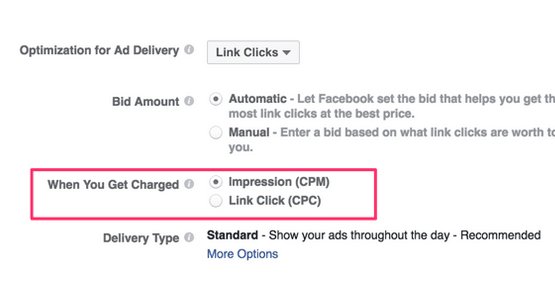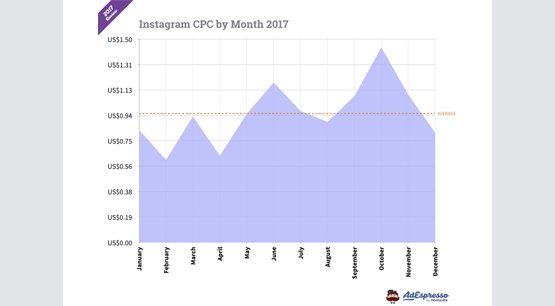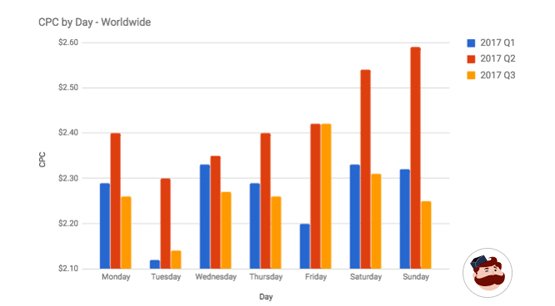CPC vs CPM Pricing: Which is Better for Instagram Ads?

In the world of web advertising, marketers always shoot for the most bang for their buck. The more your dollar can stretch, the more dollars you can make in return, and the better off your business will be.
You’re given the choice with platforms like Instagram. Do you want to pay for guaranteed clicks, or do you want to pay for exposure and hope it comes out cheaper?
CPC, CPM, and Their Differences
CPC and CPM are the two competing bid strategies for most forms of paid advertising online. They’re pretty simple, but if you don’t know how the models work, you might not know all the nuances of each.
CPC is Cost Per Click. If I say I’m running ads that have a $1 CPC, what I’m telling you is that I’m running advertising on Instagram that costs me $1 each time someone clicks on the ad.
Now, this doesn’t mean I make a sale, or get a subscriber, or get any benefit from the ad at all. People can click ads and not like what they see all the time. This is why you need to measure your conversion rate when you’re talking about any kind of paid advertising.
To figure out how much you’re actually paying for sales when you’re running CPC ads, you need to take the cost per click and compare it to your conversion rate. If, say, you have a 10% conversion rate, that means for every 10 clicks you get, you get one conversion. With a $1 CPC, that means one conversion is costing you $10. This is a piece of information you can then use to benchmark. How much profit do you get from a sale? If it’s under $15 or so, you’re not making all that much from your ads, and should do something to optimize them.
CPM is a slightly different structure. It’s Cost Per Mille, where Mille is a fancy word for 1,000. It’s the industry standard term for “how much it costs to get 1,000 views.” CPM ads are not concerned with clicks, only with views. If I tell you I’m paying $1 CPM for my ads, you know I’m getting 1,000 views for $1.
Now, this can be good and bad. If I still have a 10% conversion rate – we’ll assume that’s static for a moment – then CPM ads can be better or they can be worse. If I get 10 clicks in my 1,000 views, that’s 10 clicks and 1 conversion for $1. 1 conversion for $1 is a lot better than 1 conversion for $10 as with CPM.
On the other hand, there’s no guarantee that I’ll get 10 clicks out of my 1,000 views. It might actually take 50,000 views to get those 10 clicks, if my ads aren’t very compelling. That means I end up paying $50 for 1 conversion, which is a much worse rate than the CPC ads.
It’s pretty rare that CPM ads perform so poorly. You’re likely to get a few clicks in 1,000 views, depending on the quality of your ads. This is why the average cost per 1,000 views is higher than the average cost per click for most ads.
Instagram Benchmarks
There are a ton of different factors that go into calculating your CPM or CPC rates. Varying industries, varying levels of competition, different times of day or times of month, it all has an effect. You can read some pretty detailed analysis of CPC rates specifically in this article.
According to data from AdStage, for the first quarter of 2018, the Instagram average cost per click was $1.41. Meanwhile, the average CPM is a much higher $7.91. You need to have a pretty high click through rate with your CPM ads if you want to balance out the cost to be better than just paying for clicks directly.
Advantages and Disadvantages
The advantage of CPC advertising is that it’s a fixed – well, relatively fixed – cost for clicks. You know how much a click is going to cost you, so you can plan based on known conversion rates how much you’re able to spend, how much profit you’re likely to make, and ways to optimize any individual factor to improve those numbers.
CPM ads have a bit of uncertainty to them. If the atmosphere is right and your guesses are correct, your cost per click as calculated based on ad spend for CPM will be much lower. According to those benchmarks above, you would need about eight clicks per 1,000 views to equal the cost of CPC ads.
If you can get more than eight clicks out of your CPM ads, you stand to make a much better profit. Your CPM doesn’t adjust simply because your ads performed better. The only performance-based benefits you can get are to quality score, and that just means better ads will cost you even less. You’re rewarded for making the right choices.
It’s still another factor you need to consider, though. If your CPM ads fall flat, and you only get, say, 3 clicks in 1,000 views, that’s costing you nearly double what the CPC ads would have gotten you.
Essentially, CPM ads give you one more factor you can adjust to make your ads more compelling. If you’re good enough to make your ads draw in a lot of clicks, you can easily end up paying far less per click than you do with CPC ads.
On the other hand, CPC ads offer a guaranteed price per click. It might not be as low as you would otherwise want it to be, but it won’t balloon out of control if your ads aren’t as good as you would like them.
There exists yet another version of advertising, called CPA or Cost Per Action/Acquisition ads. These take out yet another factor and simply charge you when a user makes a purchase. They also tend to be correspondingly more expensive, and they’re also not something you can use for Instagram, so they’re irrelevant to this post. It’s worth learning about them if you use another ad system, however.
When to Use CPC
On Instagram, when should you use CPC ads and when should you opt for CPM ads instead? Let’s take a look.
As mentioned, CPC ads are more consistent. You know exactly how much you’re going to be paying for a click, and you can plan around that number. Of course, the fickle nature of the ad auctions mean those numbers can vary up and down, sometimes significantly. Even if the numbers themselves don’t vary, the efficacy of the ads might, since your bid could put you at a lower position and give you less exposure.
CPC is good when you want to reach certain click goals and know you have the budget for them. It’s also relatively consistent. Optimization, or the lack thereof, can only raise or lower your ad performance by a small amount.
Many people think of CPC as a way to get free views. Run an ad that won’t get many clicks, and you’re getting free exposure. You only pay for clicks, and if it takes showing your ad to 5,000 people to get a single click, you get 5,000 views for a very low cost.
The reality, of course, is that it’s an inefficient way to use your budget. The reason is because Instagram – since it runs on the Facebook ads platform – has algorithms in place to show your ads to the people most likely to take the relevant action. If you’re running CPC ads, it means you want clicks, and it means Instagram will preferentially show your ads to people more likely to click. If you’re trying to abuse CPC ads to get views for a low click number, you’d actually be anti-optimizing your ads, and that just makes your ads look worse.
CPC is also a good option for using small budgets to test ad campaigns. You can run three different ads for a guaranteed number of clicks and measure other related metrics, like the conversion rate, the number of impressions needed to get those clicks, and how long it took to deliver the clicks. You can then use this information for future optimizations.
When to Use CPM
When should you use CPM ads, then? They can perform worse than CPC, but they can also perform better, and it depends more heavily on how well you’re able to optimize the ads yourself.
Therefore, the number one reason to use CPM for your ads is because you know what your audience wants and you think you’ll be able to get more benefit out of them than with CPC. If you’re interested in micromanaging your ads, CPM is a great option.
CPM is also a great way to dump money from a larger budget into ads. You can run a few CPC ads to test out campaigns, find one that performs fairly well, and start with it for CPM ads. Once you confirm that it’s getting cheaper clicks and conversions than the CPC ads themselves, you can dump money into the campaign until diminishing returns make it no longer worthwhile.
CPM ads are also a good way to get visibility up, if all you need is your name and a picture of your logo or product in front of people. If you don’t care about clicks and consider them a bonus, and you’re aiming for brand awareness, CPM ads are great. They’re optimized for people seeing them, after all.
At the end of the day, it always comes down to the calculation of cost per conversion. If you can get a better cost per conversion with the CPM ads than you can with the CPC ads, it’s better to run the views. Otherwise, stick with CPC.
Modifiers
One consideration is the size of the purchase a user makes. You don’t need to care about this if you only have one product or if you’re not selling anything with your ads, but you do if you have a larger storefront.
Conversion rates and the cost per conversion only tell you one half of the story. It costs you X amount of money to get people to buy, but you also have to consider the value of what they’re purchasing.
For brands with stores that have a variety of different products, or for apps that have different pricing tiers and the like, you want to keep in mind the expected value of a purchase.
In some cases, I’ve seen companies leaving money on the table because they didn’t consider the average value of a customer. The customers they got from CPM ads were frequent buyers, those who only bought minor refills and small products, so the cart value for their ads was low. Meanwhile the CPC ads, with the right targeting, were capable of reaching new customers willing to make the initial, larger buy-in.
The true answer, of course, is to run both. Nothing limits you to running just CPC or just CPM ads on Instagram. Run a few small CPC ads to test out potential ad campaigns. The best ones should transition to CPM and test again to make sure they’re performing well. The rest can settle as CPC ads, earning some money without needing to be monitored.
CPM can be quite valuable if you’re capable of monitoring performance, but you have to be aware that if you slip, you might end up losing money.








